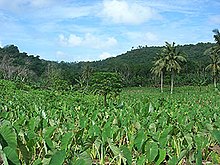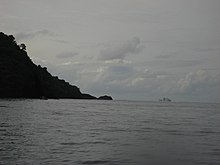Fogamaʻa Crater (Samoan: Fogāmaʻa) is a valley basin on Tutuila Island, American Samoa, immediately north of Larsen Bay. It is within the village of Futiga, just below Logotala Hill.[1] It is also known as Hidden Beach or Larsen’s Cove.[2]


It is a prominent crater on the island.[3] The Fogamaʻa Crater National Natural Landmark contains 485 acres (196 ha) and was designated in 1972. It is scenic and geologically significant as the most recent illustration of volcanism in American Samoa.[4] It is one of very few places where illustrations of the most recent episode of American Samoa volcanism can be seen.[5]
The crater is situated immediately inland from Larsen Bay, which contains two smaller coves: Fagalua and Fogamaʻa.[1] Fogamaʻa Cove is an idyllic and isolated beach on the inner margin of Larsen's Bay. There are extensive seabird breeding grounds in Larsen's Bay.[6]
Fogamaʻa Crater National Natural Landmark is located next to Fagatele Bay and also includes Steps Point,[7] the southernmost point of the island.[6]
History
editThe nearby village of Vaitogi was previously located in the Fogamaʻa Crater, where the villagers had rich soil for farming and plenty of game for hunting. However, families began leaving the area at the end of the 19th century due to ease in connecting with other villages. The present-day location of the village was much closer to other villages when traveling on foot. Vaitogians often visit Fogamaʻa to enjoy the beach and bay.[8]
See also
editReferences
edit- ^ a b Goldin, Meryl Rose (2002). Field Guide to the Samoan Archipelago: Fish, Wildlife, and Protected Areas. Bess Press. Page 282. ISBN 9781573061117.
- ^ Clayville, Melinda (2021). Explore American Samoa: The Complete Guide to Tutuila, Aunuʻu, and Manuʻa Islands. Page 64. ISBN 9798556052970.
- ^ Keating, Barbara H. and Barrie R. Bolton (2012). Geology and Offshore Mineral Resources of the Central Pacific Basin. Springer Science & Business Media. Page 146. ISBN 9781461228967.
- ^ "National Natural Landmarks - National Natural Landmarks (U.S. National Park Service)". www.nps.gov.
- ^ https://dokumen.tips/documents/national-natural-landmarks-us-national-park-service.html (Page 6)
- ^ a b "American Samoa Territorial comprehensive outdoor recreation plan". www.govinfo.gov.
- ^ http://www.npshistory.com/publications/npsa/feasibility-study.pdf (Page 65)
- ^ Faiʻivae, Alex Godinet (2018). Ole Manuō o Tala Tuʻu Ma Fisaga o Tala Ave. Amerika Samoa Humanities Council. Page 117. ISBN 9781546229070.